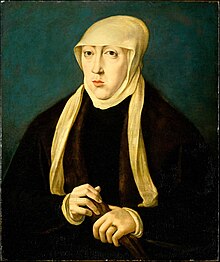Mary of Austria, Queen of Hungary
| Mary of Austria | |
|---|---|

Portrait by Jan Cornelisz Vermeyen
|
|
| Queen consort of Hungary and Bohemia | |
| Tenure | 22 July 1515 – 29 August 1526 |
| Coronation | 11 December 1521 (Hungary) 1 June 1522 (Bohemia) |
| Governor of the Habsburg Netherlands | |
| Tenure | January 1531 – October 1555 |
| Born | 15 September 1505 Brussels |
| Died | 18 October 1558 (aged 53) Cigales |
| Burial | El Escorial |
| Spouse | Louis II of Hungary |
| House | House of Habsburg |
| Father | Philip I of Castile |
| Mother | Joanna of Castile |
| Religion |
Christianity (Roman Catholicism) |
| Signature |  |
Mary of Austria (15 September 1505 – 18 October 1558), also known as Mary of Hungary, was queen consort of Hungary and Bohemia as the wife of King Louis II, and was later Governor of the Habsburg Netherlands.
The daughter of Queen Joanna and King Philip I of Castile, Mary married King Louis II of Hungary and Bohemia in 1515. Their marriage was happy but short and childless. Upon her husband's death following the Battle of Mohács in 1526, Queen Mary governed Hungary as regent in the name of the new king, her brother, Ferdinand I.
Following the death of their aunt Margaret in 1530, Mary was asked by her eldest brother, Emperor Charles V, to assume the governance of the Netherlands and guardianship over their nieces, Dorothea and Christina of Denmark. As governor of the Netherlands, Mary faced riots and a difficult relationship with the Emperor. Throughout her tenure she continuously attempted to ensure peace between the Emperor and the King of France. Although she never enjoyed governing and asked for permission to resign several times, the Queen succeeded in creating a unity between the provinces, as well as in securing for them a measure of independence from both France and the Holy Roman Empire. After her final resignation, the frail Queen moved to Castile, where she died.
Having inherited the Habsburg lip and not very feminine looks, Mary was not considered physically attractive. Her portraits, letters, and comments by her contemporaries do not assign her the easy Burgundian charm possessed by her grandmother, Duchess Mary of Burgundy, and her aunt Margaret. Nevertheless, she proved to be a determined and skillful politician, as well as an enthusiastic patron of literature, music, and hunting.
...
Wikipedia
